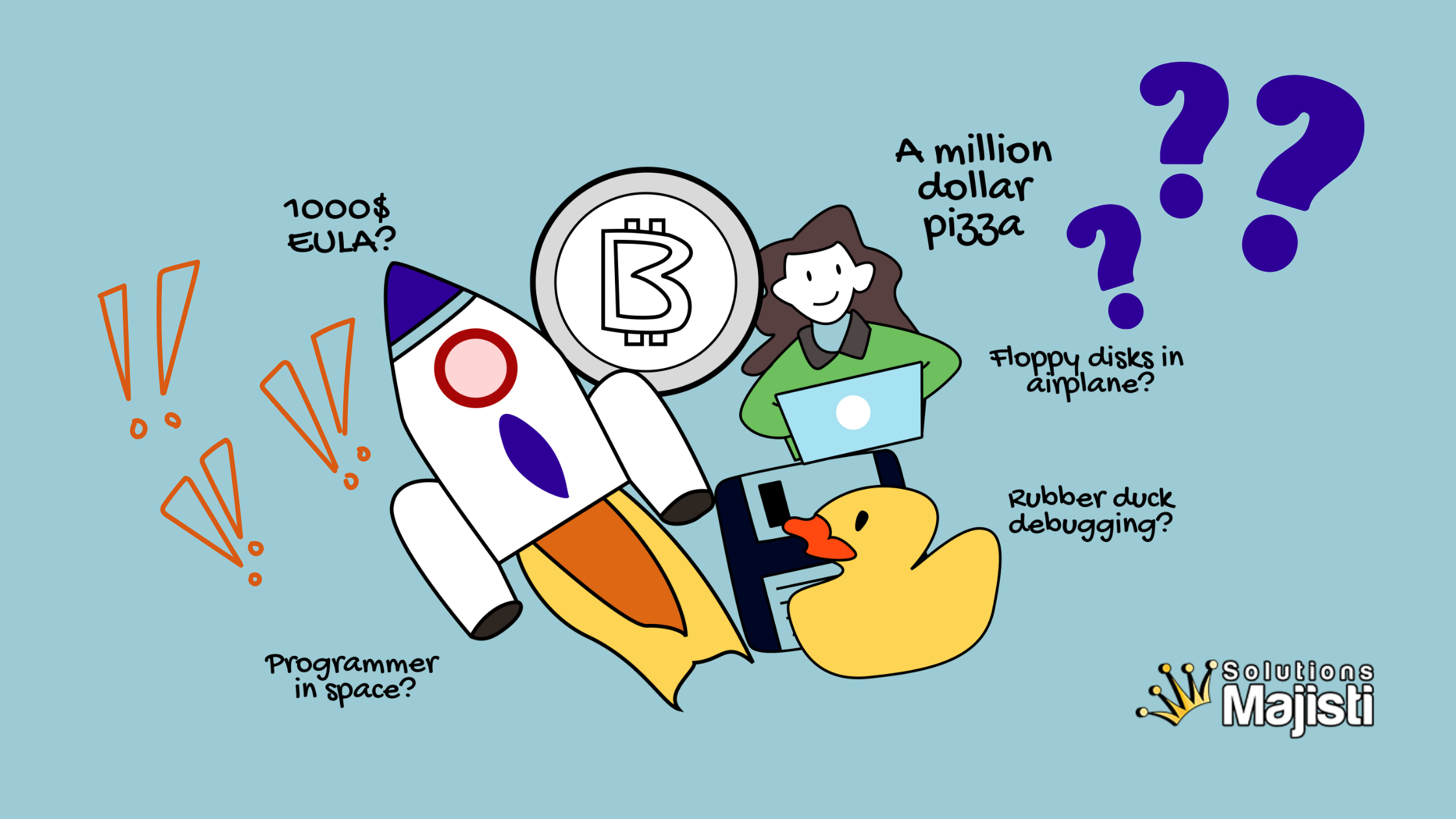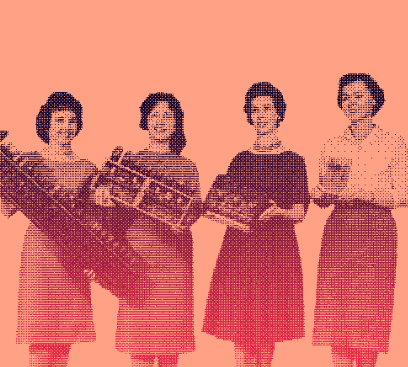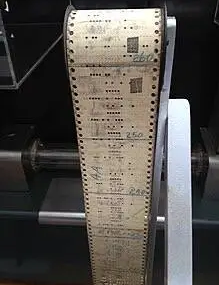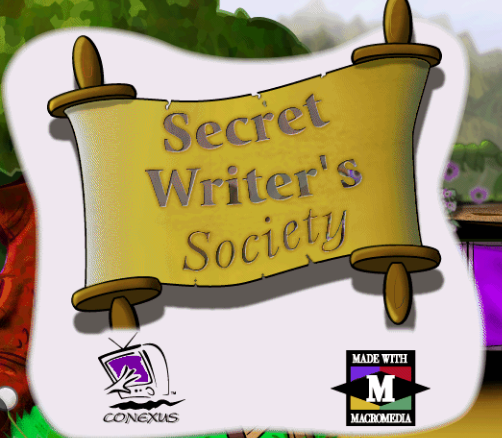20 Unexpected Technology Facts That Will Amaze You
 Cirila Gervacio
Cirila GervacioTable of contents
- 1. The Ones That Got Away
- 2. Rubber Duck
- 3. Gonna Catch 'Em All
- 4. An Expensive Hyphen
- 5. Million-Dollar Pizza
- 6. Girl Power
- 7. Anonymous Founder
- 8. Message Sent
- 9. Not So Modern Aircraft
- 10. Patching the Bugs
- 11. Terms and Conditions
- 12. Secret Writer's Society
- 13. A Costly Bug
- 14. MS-DOS
- 15. Adobe & Blue's Clues
- 16. Free Coffee, Anyone?
- 17. Auto-Tune
- 18. Games Over the Air
- 19. A Software Billionaire on Space
- 20. First Camera Phone

1. The Ones That Got Away
Four Atari programmers—David Crane, Larry Kaplan, Alan Miller, and Bob Whitehead—were so frustrated by Atari’s lack of recognition that they demanded the same respect and royalties as musicians get from record labels. When Atari’s CEO, Ray Kassar, scoffed at their contributions, calling them “towel designers” and claiming “anyone can do a cartridge,” the team left and founded Activision in October 1979 together with former music industry executive Jim Levy and venture capitalist Richard Muchmore.

2. Rubber Duck
Rubber duck debugging is a method where a programmer explains their code, line by line, to an inanimate object, typically a rubber duck. The name comes from a passage in "The Pragmatic Programmer" by Andrew Hunt and David Thomas, where a programmer keeps a rubber duck on their desk. When faced with a complex problem, they would explain their code to the duck as if it were a novice, which helps them think more clearly and identify errors.
Fun Fact: On April 1, 2018, Stack Exchange played an April Fools' joke by introducing a rubber duck avatar called Quack Overflow. The duck appeared on screen, offering to help with coding problems but would only respond with a quack sound after "thinking" and "typing."
3. Gonna Catch 'Em All
The beloved Pokémon Gold and Silver games, which sold an amazing 23 million copies, were created by just four dedicated programmers. They aimed to release the game in 1998, right when the first season of the anime was wrapping up. But Shigeki Morimoto, one of the programmers, mentioned that the long development time—three and a half years—was partly because their team was so small.Despite their small size, they managed to create a massive and innovative game that remains a fan favorite.
4. An Expensive Hyphen
In 1962, the Mariner I rocket was destroyed shortly after launch due to a single missing hyphen in its guidance software. This minor error caused the rocket to veer off course and explode, resulting in a loss estimated at $80 million at the time—about $630 million today.
Following the Mariner I incident, NASA implemented stricter quality control and review processes for software. This included more rigorous testing procedures and code reviews to prevent similar issues in future missions.
5. Million-Dollar Pizza
The first "real-world transaction" with Bitcoin took place in 2010 when a programmer named Laszlo Hanyecz, paid 10,000 bitcoins for two large Papa John’s pizzas. At that time, Bitcoin was worth just a fraction of a cent and the transaction was estimated to be only $41. However, just four years later, those 10,000 bitcoins would have been valued at approximately $5.12 million!
Fun Fact: May 22, 2010, is celebrated annually as "Bitcoin Pizza Day" in the cryptocurrency community.
6. Girl Power

The original programmers of the first supercomputer, the ENIAC, in 1946 were all women! Known as the "ENIAC women," these pioneers—Kathleen Antonelli, Betty Jennings, Marlyn Wescoff, and others—were instrumental in programming the massive machine, which marked a significant milestone in computing history.
The ENIAC women were tasked with debugging and programming the ENIAC, a machine with over 17,000 vacuum tubes. Their innovative problem-solving skills included creating detailed flowcharts and writing complex programs by manually setting switches and plugging in cables. They effectively created some of the earliest methods of computer programming.
7. Anonymous Founder
Satoshi Nakamoto introduced Bitcoin in a 2008 whitepaper titled “Bitcoin: A Peer-to-Peer Electronic Cash System,” which outlined a decentralized digital currency. Nakamoto’s true identity remains a mystery. The name Satoshi Nakamoto could refer to an individual or a group of people. Nakamoto communicated with the early Bitcoin community through online forums and emails but has not been publicly identified or contacted since 2010.
8. Message Sent
In October 29, 1969, the first message sent over ARPANET—the precursor to the modern internet—was “LO.” This event was recorded in the "IMP Log" at UCLA. Professor Leonard Kleinrock supervised his student/programmer Charley Kline in setting up the transmission.
They aimed to send a "login" message from the UCLA SDS Sigma 7 Host computer to the SRI SDS 940 Host computer, where Bill Duvall was stationed. The transmission was intended to authenticate the connection between the two systems. The system successfully transmitted the letters "l" and "o" before crashing, leading to the first message on the internet being recorded as "lo." The complete login was achieved approximately an hour later. The crash was due to a buffer overflow, where the network was not yet capable of handling the full data request.
9. Not So Modern Aircraft
Many Boeing 747s are still updated with software via 3.5-inch floppy disks. Despite being a technology from the 1980s, these floppy disks are used to ensure that the critical systems on these aircraft remain functional and secure.
Security researchers at Pen Test Partners recently gained access to a retired British Airways 747, following the airline’s decision to ground its fleet due to a decline in travel during the coronavirus pandemic. During their inspection of the plane’s avionics bay—equipped with data center-like racks of modular black boxes—they discovered a 3.5-inch floppy disk drive in the cockpit. This vintage technology is used to load crucial navigation databases that need updating every 28 days, with an engineer making monthly visits to install the latest updates.
10. Patching the Bugs
The term "patch" for software updates comes from early computing practices with punch cards. In the 1950s and 60s, computers were programmed using cards with holes representing code instructions. When bugs were found, programmers would physically alter these cards by placing a patch over a hole and punching a new hole to correct the code. This manual correction process gave rise to the term "patch," which now refers to updates or fixes applied to software to address bugs or improve functionality.
Here is a picture of a program tape for the 1944 Harvard Mark I, one of the first digital computers. Notice the physical patches used to correct punched holes by covering them. Source: Wikipedia.

11. Terms and Conditions
In 2005, Doug Heckman came across a unique clause in an End User License Agreement (EULA) from installing a PC Pitstop program. In it, he found a clause stating that he could get financial compensation if he e-mailed PC Pitstop. Intrigued by this unusual offer, Heckman carefully read through the entire EULA. After completing the document, he contacted the company to claim his reward.
The company honored their promise and sent Heckman a check for $1,000, recognizing that he had fulfilled the conditions outlined in the agreement.
12. Secret Writer's Society
The game Secret Writer’s Society, launched in 1998, was designed to help young children learn to read and write through fun activities. Despite its early success, it is now mostly forgotten, with its website disappearing around 2001. The game included a diary for kids to write in and a text-to-speech tool to read their entries aloud. To prevent inappropriate content, developers added a swear filter to block offensive words. However, the filter had issues, leading to unintended and funny results. Double-clicking 'Read' would activate the swear filter instead of reading what was written.

13. A Costly Bug
On August 1, 2012, Knight Capital experienced a catastrophic failure due to a software glitch. The issue was traced back to a configuration error: a crucial flag in their trading software was not set correctly. This error was a result of the deployment of new trading algorithms without thorough testing.
The failure caused Knight Capital’s trading algorithms to execute a large number of unintended trades in a short period. This flood of erroneous trades resulted in a loss of approximately $460 million within just 45 minutes.
14. MS-DOS
In 1981, IBM approached Microsoft for help in finding an operating system for their new PC. Initially, Gates directed IBM to Gary Kildall, who was known for his operating system CPM. However, when IBM representatives visited Kildall, he was unavailable, as he was out flying his private plane. IBM’s attempt to get his wife, Dorothy, to sign an NDA to cover their visit was unsuccessful.
Frustrated by the failed attempt to negotiate with Kildall, IBM returned to Gates and pressed him to provide an OS. Gates, eager to secure the deal, agreed to develop an OS for IBM.
Gates didn’t develop an OS from scratch. Instead, he bought a program called Q-DOS, created by Timothy Paterson, Programmer at Seattle Computer Products, for $75,000. Q-DOS was essentially a modified version of Kildall’s CPM. Gates and Microsoft rebranded Q-DOS as MS-DOS (Microsoft Disk Operating System) and licensed it to IBM.
15. Adobe & Blue's Clues
Blue’s Clues was one of the first shows to use Adobe software on a television production. They were able to produce episodes four times faster than traditional methods as a result, surprising even Adobe themselves. When Adobe found out they were stunned and had no idea their products could be used to create something so complex. This lead to the animators being brought to Adobe to improve the software.

16. Free Coffee, Anyone?
In 2013, Douwe Egberts, a South African coffee company, launched an incredibly clever marketing campaign: a coffee vending machine that uses facial recognition to detect when a person yawns and then dispenses a free coffee. They installed the vending machine at O.R. Tambo International Airport in Johannesburg, South Africa.
Before Douwe Egberts' campaign, there were other instances where facial recognition technology was used in vending machines and other automated systems, primarily for security or access control purposes. However, these applications were often focused on identifying individuals rather than interacting with them in a consumer-oriented way.
17. Auto-Tune
Auto-Tune, the pitch-correcting software, was created by Dr. Andy Hildebrand in 1997. Originally developed for correcting pitch in audio recordings, Auto-Tune became a revolutionary tool in music production. The first high-profile use of this technology was on Cher’s 1998 hit “Believe." The software was used in such a way that it altered Cher’s voice to create a futuristic, electronic sound. This application of Auto-Tune was not meant to correct pitch but to produce a unique audio effect.
It's pretty wild, but Auto-Tune wasn’t originally meant for music. It actually started in the oil industry. Dr. Andy Hildebrand, who worked for Exxon at the time, created some fancy algorithms for Antares Audio Technologies to help find oil deposits using sonar data.
The music angle came up when a colleague joked that his tech might help her stay on pitch. That got Dr. Hildebrand thinking, and he decided to tweak his algorithms for pitch correction, leading to the Auto-Tune we know today.
18. Games Over the Air
In the 1980s, computer enthusiasts downloaded games over the radio by transmitting data as audio signals. This process used early modems and software to decode the radio tones into digital files. Transfer rates were slow, and the method was prone to errors, but it was a creative way to share software before the internet. Standard radios and early home computers like the Commodore 64 were involved, and it was popular in local communities and radio shows.
Early games were often text-based adventures or simple graphics due to technological limitations. A notable program, “Hobbyscoop,” was launched by NOS to broadcast gaming data and became very popular. They also created the BASICODE cassette format to ensure compatibility. Radio shows dedicated to game transmission emerged globally, including the Yugoslavian station “Ventilator 202,” which aired 150 programs from 1983 to 1986. Over time, this method evolved to share not just games but also educational tools, encyclopedias, and flight simulators, reflecting its practical utility beyond just novelty.
Distributing programs via the radio came to an end in the mid- to late- 1980s when 8-bit computing gave way to 16-bit computing. Consequently, cassette storage became a thing of the past, and floppy disk and hard disk drives became the preferred mass storage devices.
19. A Software Billionaire on Space
Charles Simonyi, the Hungarian-born billionaire behind the creation of Microsoft Word and Excel, was the first billionaire to go to space. Simonyi was paid a total of $60 million for two trips to the International Space Station in 2007 and 2009. He entered orbit and spent a total of 4 weeks in space.
Fun Fact: Charles Simonyi introduced the graphical user interface to Bill Gates for the first time who later described it as the first of two revolutionary things he felt in his life
20. First Camera Phone
On June 11, 1997, Philippe Kahn, a software entrepreneur, wanted to share the moment of his daughter’s birth with family and friends immediately. He connected a digital camera to his flip phone using a wire he improvised from his car telephone. Fortunately, his wife spent 18 hours in labor, giving him enough time to get the system working before his daughter was born. All the components he needed were either in his car or available at a local Radio Shack, where he sent an assistant. With a few lines of code he wrote on his laptop, he successfully linked the devices. Thanks to this technology, Kahn was able to instantly send the photo to over 2,000 people. The recipients were puzzled, unable to understand how Kahn managed to take and share a photo while still at the hospital.
In 2016, Time Magazine named Kahn’s camera phone photo one of the 100 most influential photos of all time. In 2017, the marketing studio Conscious Minds released a heartwarming 4-minute short film recreating the story of Kahn’s now-famous photo. In 2000, Sharp used Kahn's technology to release the first commercially available camera phone.
Related sources:
https://scienceandfilm.org/articles/3126/the-birth-of-the-camera-phone
https://www.theguardian.com/world/2009/mar/26/space-tourist-simonyi
https://www.amusingplanet.com/2019/04/people-once-downloaded-games-from-radio.html
https://www.bbc.com/news/entertainment-arts-22514705
https://adage.com/creativity/work/bye-bye-red-eye/32154
https://lostmediawiki.com/Secret_Writer%27s_Society_(found_educational_writing_game;_1998)
https://www.pcmatic.com/blog/4-years-later-pc-pitstop-eula-experiment-still-the-buzz/
https://www.investopedia.com/terms/s/satoshi-nakamoto.asp
https://www.gamedeveloper.com/business/the-history-of-activision
Subscribe to my newsletter
Read articles from Cirila Gervacio directly inside your inbox. Subscribe to the newsletter, and don't miss out.
Written by

Cirila Gervacio
Cirila Gervacio
I am a web developer working at Majisti Inc. - a JAMstack web development company
